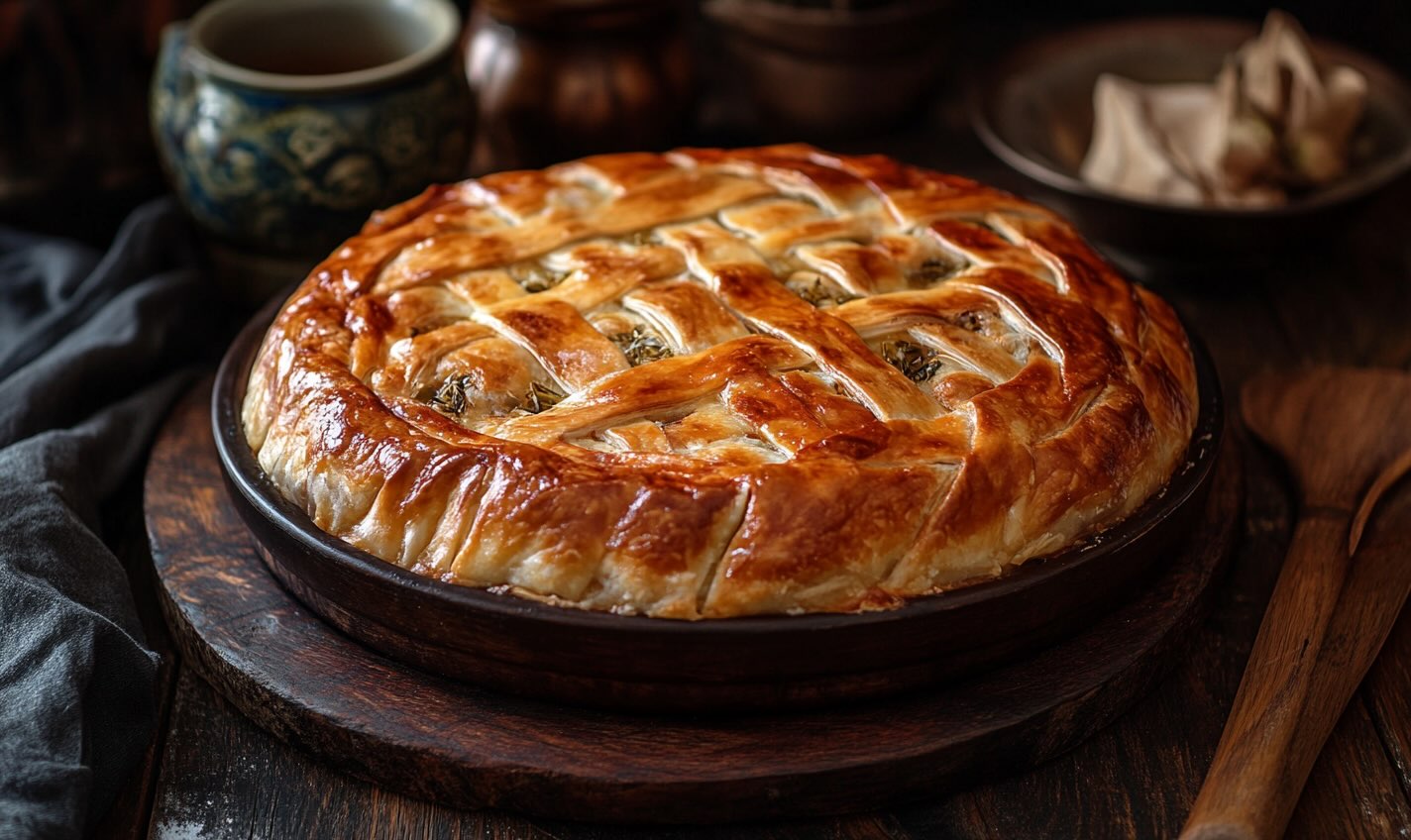Ossetian Pies: A Culinary Journey Through History, Origin, and Recipes
Ossetian Pies
Ossetian pies, a traditional culinary delight hailing from the Caucasus region, specifically the Republic of North Ossetia-Alania in Russia, are a remarkable embodiment of the rich cultural heritage of the Ossetian people. Known locally as ‘фыд’, these savory pastries have become a staple in Ossetian cuisine, making them a beloved dish for generations. Their significance transcends mere sustenance; they play an important role in Ossetian traditions and celebrations, often served during weddings, holidays, and family gatherings.
Characterized by a thick, soft dough, Ossetian pies are typically filled with a variety of ingredients, which may include potatoes, cheese, and meat. The unique technique of preparing these pies involves a combination of baking and steaming, resulting in a flavorful and moist interior encased within a golden crust. Additionally, the presentation of the pies is often artistic, with some being left open-faced, showcasing their delectable fillings, while others are neatly sealed. This attention to detail provides not only a feast for the palate but also for the eyes, contributing to their allure.
What sets Ossetian pies apart from other regional pastries is the strong emphasis on freshness and quality of ingredients, often sourced from local farms and markets. This commitment to authenticity not only enriches the flavor but also connects the dish to the area’s agricultural roots. Furthermore, the versatility of Ossetian pies allows for numerous variations that cater to diverse tastes and preferences, making them particularly appealing to a wide audience. As we explore the historical journey and different recipes associated with these pies, it becomes clear that they are much more than just food; they represent a deep connection to Ossetian identity and community.
The Historical Roots of Ossetian Pies
Ossetian pies, known as “feishu,” hold a significant place in the culinary traditions of the Ossetian people, whose history dates back to the early inhabitants of the Caucasus region. The origins of these savory and sweet pastries can be traced as far as the first millennium BC, indicating a deep-rooted connection to agricultural practices that shaped the local diet over centuries. The fertile lands of the Caucasus, characterized by a diverse range of crops, provided the necessary ingredients for these pies, making them a staple in the Ossetian diet.
Throughout history, various historical events have further influenced the evolution of Ossetian pies. The migration of the Ossetians, their interactions with neighboring cultures, and the impact of invasions all led to the incorporation of diverse flavors and techniques into the traditional pie-making process. The influence of Georgian, Russian, and even Persian cuisines can be observed in some variations of Ossetian pies, showcasing the cultural exchange that has taken place in this region.
Ossetian pies also carry substantial cultural significance, particularly in local customs and traditions. They are often prepared during significant events and celebrations, such as weddings and the end of harvest festivals, symbolizing abundance and unity among family members. The act of pie-making is often a communal activity, where family members gather to create these delicious pastries, creating bonds and memories. Additionally, each variety of pie, whether it be filled with cheese, potatoes, or sweet fruits, reflects the customs and personal stories of the Ossetian people.
In essence, Ossetian pies are not merely a dish; they represent the history, cultural identity, and agricultural heritage of the Ossetian community. As the culinary journey continues, these pies remain a testament to resilience and tradition, celebrated in every bite.
The Cultural Significance of Ossetian Pies
Ossetian pies hold a central place in the culinary and social fabric of Ossetian culture, acting as a symbol of hospitality and community. Traditionally, these pies are not merely a source of sustenance; they embody the spirit of sharing and togetherness, often being prepared for gatherings, celebrations, and family events. When serving Ossetian pies, hosts convey warmth and generosity, inviting guests to partake in a meal that is steeped in tradition. The process of making these pies often involves family collaboration, further emphasizing the importance of communal bonds in Ossetian society.
Various regional variations of Ossetian pies reflect the unique customs and occasions celebrated within different communities. For instance, on festive occasions such as weddings or religious holidays, specially crafted pies may be prepared that incorporate local ingredients or are shaped in particular forms to symbolize blessings and good fortune. These regional adaptations highlight the versatility of Ossetian pies while maintaining their traditional essence, illustrating how food can adapt to cultural and social contexts.
Moreover, Ossetian pies resonate deeply within the realm of folklore and rituals. They often appear in tales and legends, serving symbolic purposes that connect the past with the present. In Ossetian culture, pies can signify prosperity, fertility, and the cycles of nature, often being included in rituals that mark significant life events. Through these narratives, the preparation and consumption of pies become a living tradition that sustains cultural identity across generations. The significance attached to these pies transcends mere culinary aspects, revealing a profound connection between food, culture, and the community itself.
Ingredients Used in Ossetian Pies
Ossetian pies, or “chedar,” are a culinary delight known for their rich flavors and diverse ingredients. To create the perfect Ossetian pie, the selection of fresh and local products is paramount. The foundation of these pastries lies in the dough, which is traditionally made using wheat flour. However, variants may incorporate rye or corn flour, lending a distinct flavor and texture to the crust. The choice of flour plays a significant role in the overall character of the pie, influencing its taste and satisfaction.
When it comes to the filling, various ingredients are employed, with meat being a primary constituent. Ossetian pies typically contain minced lamb, beef, or pork, often combined with an array of herbs like dill and parsley. The meats provide a savory element, while the herbs introduce freshness, balancing the richness of the filling. Aside from meat, dairy products, notably quark or cottage cheese, are also commonly used. This addition not only enhances the creaminess but also reflects the region’s dairy farming traditions.
Furthermore, atypical ingredients provide an extra layer of uniqueness to Ossetian pies. For instance, some variations include vegetables like potatoes or pumpkin, creating a delightful combination of flavors and textures. These ingredients are carefully chosen to complement the primary elements, allowing each bite to showcase the harmony of tastes inherent in Ossetian cuisine. Nuts, particularly walnuts, may also be used in some recipes, contributing a crunchy texture and a nuanced flavor profile.
Ultimately, the attention given to sourcing quality ingredients helps ensure that each Ossetian pie is both delicious and reflective of the culinary heritage of the region. The careful integration of fresh meats, herbs, dairy, and unique fillers enhances the overall appeal of this traditional dish and invites a deeper appreciation of its historical significance.
Types of Ossetian Pies: A Closer Look
Ossetian pies, renowned for their rich flavors and cultural significance, come in a variety of types that reflect the diverse culinary landscape of Ossetia. Among the most well-known varieties is the ‘fydzhin.’ This pie is traditionally filled with cheese, often a blend of local cheeses such as ‘kosti’ and ‘fydzhin.’ The preparation involves a delightful mix of soft dough encasing the creamy filling, resulting in a light, savory experience that embodies the region’s dairy-rich environment. The ‘fydzhin’ has deep roots in Ossetian culture, often served at festive occasions and gatherings, making it a beloved staple.
Another prominent type is ‘kakh,’ which is a meat-filled variation that typically utilizes minced lamb or beef, complemented by aromatic herbs and spices. This hearty pie serves not only as a nourishing meal but also as a symbol of hospitality. The preparation of ‘kakh’ often involves a meticulous process where the meat is marinated and pre-cooked before being enveloped in dough. This method enhances the flavors and ensures a succulent filling that captivates the palate.
Seasonal Ossetian pies are yet another intriguing category, showcasing the availability of local vegetables through the year. These variations might incorporate ingredients such as pumpkin, spinach, or potatoes, depending on the harvest. By using seasonal produce, these pies celebrate the region’s agricultural bounty and provide a fresh twist to traditional recipes. The adaptability of Ossetian pies allows for constant innovation, with families often passing down unique recipes that highlight local ingredients.
The diversity of Ossetian pies illustrates their significance in the culinary heritage of Ossetia. Each type, from ‘fydzhin’ to ‘kakh’ and beyond, not only represents regional flavors but also serves as a reminder of the cultural practices and communal values embedded in Ossetian society.
Traditional Recipes for Ossetian Pies
Ossetian pies, known as “chuft” or “kardon,” are a celebration of culinary heritage from the Ossetian region in the Caucasus. These savory pastries come in various forms, featuring a delightful combination of dough and filling. Below are traditional recipes that allow for personal modifications to cater to specific dietary requirements.
Classic Ossetian Pie with Cheese and Potatoes
For this recipe, you will need:
- 3 cups all-purpose flour
- 1 cup warm water
- 1 tablespoon salt
- 1 packet (2¼ teaspoons) active dry yeast
- 1 cup potato, boiled and mashed
- 1 cup Ossetian cheese or a mix of feta and mozzarella
- 1 onion, finely chopped
- Butter for greasing
Instructions:
- In a small bowl, mix warm water with yeast and allow it to sit for about 10 minutes until frothy.
- In a large bowl, combine flour and salt, then gradually add the yeast mixture. Knead until the dough is smooth and elastic. Let it rise for 1 hour in a warm place.
- For the filling, mix the mashed potato, cheese, and onion in a separate bowl. Season to taste.
- Preheat the oven to 375°F (190°C).
- Once the dough has risen, divide it into equal portions and roll each into a circle. Place the filling in the center and fold the dough over to create a half-moon shape. Pinch the edges to seal.
- Transfer to a greased baking sheet. Bake for 30-35 minutes or until golden brown.
Vegetarian Option: Spinach and Feta Filling
For those seeking a vegetarian alternative, substitute the potato and cheese with sautéed spinach and feta cheese. Follow the same preparation and baking instructions to achieve a delicious, plant-based pie.
Incorporating family stories or traditions while preparing these recipes can enrich the experience and deepen the appreciation for Ossetian culture. Enjoying Ossetian pies during family gatherings not only satisfies hunger but also fosters connections to heritage and shared history.
Modern Takes on Ossetian Pies
In recent years, Ossetian pies have experienced a resurgence in popularity, inspiring contemporary chefs and home cooks to reinterpret this traditional dish. These modern adaptations maintain the essence of the original recipes while introducing inventive flavors and techniques that cater to a diverse audience. Offering a balance of heritage and innovation, these variations allow Ossetian pies to thrive in today’s culinary landscape.
One significant aspect of this evolution is the incorporation of global ingredients to create unique twists on classic pies. For instance, chefs have experimented by adding local vegetables, proteins, and spices to the fillings, resulting in fusion recipes that maintain the cherished dough but offer exciting new flavors. Dishes such as Ossetian pies filled with feta cheese and sun-dried tomatoes or spiced lentils and cumin showcase how elements from different cuisines can enhance traditional Ossetian flavors, appealing to both local and international palates.
Moreover, modern cooking techniques, such as sous-vide cooking and the use of air fryers, have gained popularity, impacting how these pies are prepared. These methods not only streamline the cooking process but also allow for health-conscious modifications, such as using whole-grain flours or vegetable-based fillings that retain the robust taste of Ossetian pies while making them more accessible to those with varying dietary preferences.
The influence of globalization has undeniably shaped the way Ossetian pies are presented and consumed. Social media platforms showcase homemade variations and inspire chefs to push the boundaries of traditional cuisine. As creativity flourishes, it becomes evident that the journey of Ossetian pies may be intertwined with other culinary traditions, ensuring that this cherished dish remains relevant in contemporary gastronomy.
Serving and Enjoying Ossetian Pies
Ossetian pies, known as “khozha,” are a staple in Ossetian cuisine, celebrated not only for their rich flavors but also for the manner in which they are traditionally served and enjoyed. Often presented at festive gatherings, family meals, or everyday dining, these savory pastries play a pivotal role in the social fabric of Ossetian culture. Typically, they are served warm, allowing the irresistible aroma of freshly baked crust and fillings to entice those present. It is customary to cut the pies into wedges, facilitating easy sharing and communal enjoyment.
When it comes to accompanying beverages, traditional choices include a variety of beverages such as homemade yogurt drink, buttermilk, or even herbal teas, all of which complement the hearty flavors of the pies. These drinks not only enhance the culinary experience but also offer relief from the richness of the fillings. For those seeking an alternative pairing, red wine or a light sparkling beverage may also harmonize well with the savory nature of these dishes.
Moreover, the act of sharing Ossetian pies is steeped in meaning. During gatherings, it is common for hosts to offer a piece of pie to each guest, symbolizing hospitality and the warmth of their welcome. This practice is especially significant during celebrations like weddings and holidays, where the pie serves as a centerpiece. In such contexts, the sharing of pies fosters a sense of togetherness, encouraging conversations and connections among individuals. Thus, enjoying Ossetian pies goes beyond mere consumption; it represents a cherished tradition, reinforcing bonds within families and communities.
Where to Find Ossetian Pies Today
Ossetian pies, with their rich flavors and unique fillings, have garnered a growing interest beyond their native region of North Ossetia. For those seeking to embark on a culinary journey to experience these delightful pastries, various avenues are available to explore. A great starting point is to visit specialized restaurants that feature Ossetian cuisine. Many urban areas around the globe now boast eateries dedicated to this culinary tradition, where you can savor authentic Ossetian pies made by skilled chefs. A simple online search or review of local dining guides can point you in the right direction.
In addition to restaurants, local markets and food festivals often showcase Ossetian pies. Participating in these events allows food enthusiasts to taste the diversity of pies and engage with local chefs and artisans who pride themselves on their traditional recipes. These gatherings often highlight the seasonal ingredients and regional variations found within Ossetian cuisine, providing a deeper appreciation for its historical and cultural context. Furthermore, such venues often facilitate connections with producers and chefs committed to preserving this rich culinary heritage.
To support the growing community of Ossetian chefs and artisans, consider purchasing pies directly from local vendors or small-scale bakeries known for their authenticity. Engaging with these local businesses helps ensure that these cherished recipes continue to thrive and evolve. Additionally, for those intrigued by the art of Ossetian cooking, numerous online resources and workshops are available. These platforms offer cooking classes, tutorial videos, and recipes, making it easier than ever to recreate Ossetian pies in your own kitchen.
Overall, the journey to discover Ossetian pies is enriched by the opportunity to support local chefs and immerse oneself in the culture, making each bite not just a taste of food, but a connection to history.




Post Comment